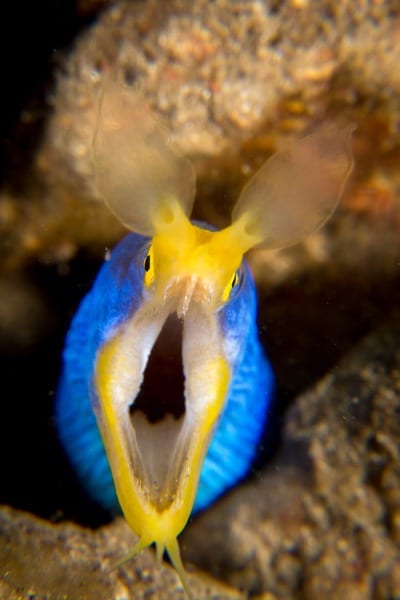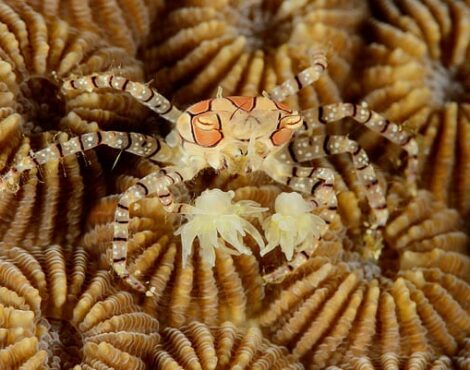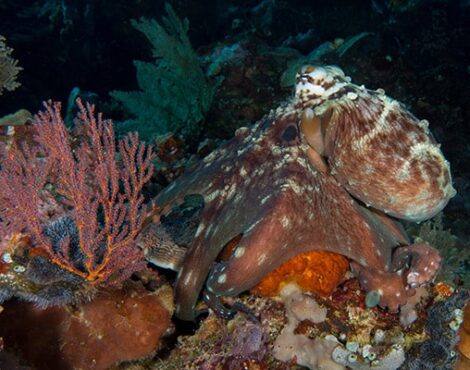For the most part whilst muck diving, you need a keen eye to spot all the fascinating and bizarre critters that choose to dwell amongst the mud and rubble. Creatures like seahorses anchor themselves against rubble, robust ghost pipefish hide in the open, relying on their superb mimicry of free floating blades of sea grass. Even more colourful species such as frogfish or leaf scorpion fish can effortlessly blend into their surroundings, only being noticed if they choose to move while you happen to be looking. Because you spend so much time concentrating on highly cryptic shapes of lacklustre hues, it can take you by surprise when something overtly colourful shows up.
The Unique Ribbon Eel: A Splash of Color Amidst the Drab
The ribbon eel, (Rhinomuraenaquaesite) is a species of moray eel like no other. While most moray eels are a dreary shade or brown or green, often mottled with patches of black or grey, ribbon eels are bright blue or yellow, sticking out against their drab background. Aside from its colour, its general appearance is unique to the rest of the Muraenidaefamily. With its slender shape, high dorsal fin, and large, anterior nostrils, the ribbon eel looks more like a mythical creature than a marine dweller. The stark differences between ribbon eels and the rest of the moray family has led many marine biologists to believe they should be in a family of their own.
Unraveling the Enigma of Ribbon Eel’s Life Cycle
Although yet to be confirmed, ribbon eels are considered a protandric hermaphrodite; meaning they begin their life as a male, before changing sex to female. This is believed because of the colour changes they experience throughout their lives. The juveniles are jet black, with a bright yellow dorsal fin. As these juveniles grow up, the black will be replaced by a vivid emerald blue. These blue and yellow individuals are the adult males, and can measure up to 1 metre in length. As the male continues to grow, the blue will be replaced by yellow, and the eel will develop the female organs. Once fully grown, a female can reach over 130cm. Such colour change is not known in any other species of moray. Once a female has fully grown, she will mate with a smaller male, and usually die in around one month. Because of this, female ribbon eels are a relatively rare sight.
Hunting Strategies and Habitual Behaviors of Ribbon Eels
These carnivorous critters use their oversized, flared nostrils to attract small fish, before clamping down with their strong jaws, pulling their victims into their burrow. As long as they are not scared, or feel threatened, they will stay in the same burrow for months, or even years. Aside from fish collectors looking to add a touch of flair to their aquariums, ribbon eels live a relatively threat free life, often spanning over 15 years. They are notoriously difficult to keep captive, and often die in less than one month. For this reason, they should never be purchased for an aquarium, even by those who have experience keeping morays.
Capturing the Allure: Photography Tips for Ribbon Eels
The vibrant colours and unique appearance make them a popular photography subject. The trick to a great shot is keeping both the eyes, and the nostrils in focus. Occasionally, you may get lucky and see one head out of its hole on an adventure. When they start swimming, you can really see why they are called ribbon eels. It literally looks like somebody is waving a blue piece of ribbon!




